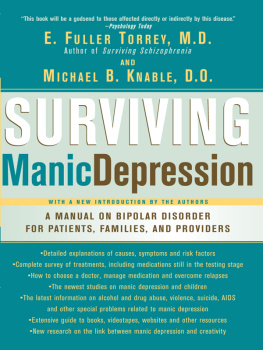Also by E. Fuller Torrey
The Roots of Treason: Ezra Pound and the Secret of St. Elizabeth's
Care of the Seriously Mentally Ill: A Rating of State Programs (with Karen Erdman, Sidney M. Wolfe, and Laurie M. Flynn)
Criminalizing the Seriously Mentally Ill: The Abuse of Jails as Mental Hospitals (with Joan Stieber, Jonathan Ezekiel, Sidney M. Wolfe, Joshua Sharfstein, John H. Noble, and Laurie M. Flynn)
Freudian Fraud: The Malignant Effect of Freud's Theory on American Thought and Culture
Schizophrenia and Manic-Depressive Disorder: The Biological Roots of Mental Illness as Revealed by the Landmark Study of Identical Twins (with Ann E. Bowler, Edward H. Taylor, and Irving I. Gottesman)
E. FULLER TORREY, M.D.





For my faithful friends Elsie Boyle and Edith Hansen
Between the idea And the reality Between the motion And the act Falls the Shadow.
T. S. Eliot
The Hollow Men
Preface
have written this book for anyone who has wondered why there are so many severely mentally ill men and women living on the streets of our cities and towns. And why there are so many severely mentally ill people in jails and prisons. And why there are so many episodes of violence by sufferers of mental illnesses, especially since we know that when such people are treated they are not more violent than the general population. This book has been written because I wondered, too.
The American health care system in general, and the psychiatric care system in particular, are undergoing massive changes. The era of Freud and the era of deinstitutionalization are ending. The era of neurobiology has begun and promises to revolutionize our understanding of the brain and its diseases. For those of use who are interested in mental illness, it is an exciting, perplexing, chaotic time, a time of crisis that demands confrontation.
I believe we know how to solve our mental illness problems, but for a variety of reasons we do not do so. This book is about those reasons. It is drawn from what I have learned from people with severe mental illnesses, from their families, and from a handful of impressively competent and caring professionals. I learned it during eight years working on the wards of a public psychiatric hospital, fourteen years running a clinic for mentally ill persons who are homeless, and visits to public shelters in eighteen states and jails in fourteen states.
Most important, I bring to this book what I have learned from my sister, who has had the misfortune to have suffered from schizophrenia for forty years. The care she has received has varied from very good to grossly negligent. She too has suffered because of the failure of the mental illness treatment system. And she too has lived much of her life in the shadows.
Some of my recommendations may not be politically correct, but 1be- lieve they are factually correct.
E. FULLER TORREY
Acknowledgments
am indebted to many people for help with this book. Robert Taylor and Sidney Wolfe allowed me to pick their brains and criticized an early draft of the manuscript. D. J. Jaffe and Harry Schnibble not only were helpful readers but also provided many useful clippings. Faith Dickerson, C. J. Dombrowski, Marilyn Moon, and Sally Satel offered additional suggestions, and the book is better because of their help.
Many people responded politely and patiently to my calls and requests for information: I want especially to thank Debbie Allness, Carol Bush, Camille Callahan, Winifred Carson, Kenneth Dudek, Richard Elliott, James Finley, Joyce and Harold Friedman, William Goldman, David Hanig, Michael Hogan, Alan Kaufman, Susan Kuper, Alana Landey, Carolyn Lewis, Chris Matkovich, Bentson McFarland, Mark Olfson, Edie Raffel, William Shaw, Peggy Straw, Mary Sullivan, Mary Ann Test, and Steven Veit.
I also wish to thank Larry Allen, Iowa Department of Human Services, for permission to use his diagram of funding sources for mental health services and Debra Srebnik, University of Washington, for permission to quote from their evaluation surveys.
Patrice DeHaven, Laverne Corum, and Dera Thompson helped with library work and the location of obscure references. Kyle Christiansen assisted with the figures and graphs.
Judy Miller typed and edited the manuscript in her usual cheerful and meticulous manner. Jo Ann Miller encouraged the idea and gave it a home at John Wiley & Sons.
My largest debt is to Barbara, my wife, best reader, and best friend.
Contents
Chapter 1
PEOPLE IN THE SHADOWS:
THE MANY FACES OF MENTAL ILLNESS
Well, we have to take our share of the illnesses of our time, and it seems after all only right that-having lived for years in relatively good health-we should sooner or later receive our part. As for me, you must know that I shouldn't precisely have chosen madness if there had been any choice, but once such a thing has taken hold of you, you can't very well get out of it.'
-VINCENT VAN GOGH, from an 1889 letter written while he was involuntarily confined in a psychiatric hospital
in the shadows of mental illness there are many faces. One is that of Thomas McGuire (not his real name), a 45-year-old human resource specialist who for 15 years had been employed by a large manufacturing firm. A college graduate, he had served with the Air Force in Vietnam, had been married for 22 years, and had a teenage son and daughter. He lived in a large city in the eastern United States and used a prestigious university teaching hospital for emergency medical care.
On March 19, 1985, Mr. McGuire went to the emergency room complaining of chest pain and shortness of breath. An electrocardiogram confirmed he was having a heart attack. He was admitted to the hospital and treated for his heart problem. During the admission process, doctors carefully explored precipitating risk factors such as hypertension, cholesterol level, smoking, and work stress. Upon discharge, Mr. McGuire was enrolled in a follow-up program to decrease his cholesterol level and thereby reduce the chances of his having another heart attack.











